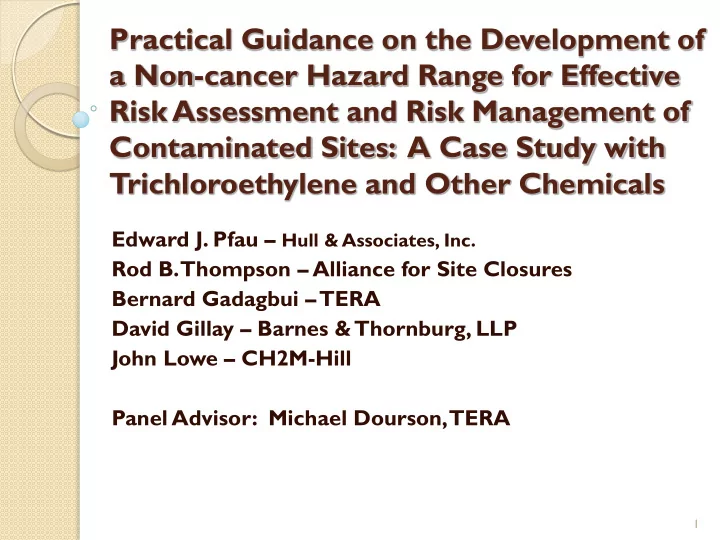

Practical Guidance on the Development of a Non-cancer Hazard Range for Effective Risk Assessment and Risk Management of Contaminated Sites: A Case Study with Trichloroethylene and Other Chemicals Edward J. Pfau – Hull & Associates, Inc. Rod B. Thompson – Alliance for Site Closures Bernard Gadagbui – TERA David Gillay – Barnes & Thornburg, LLP John Lowe – CH2M-Hill Panel Advisor: Michael Dourson, TERA 1
Problem Formulation Hazardous waste site remedial objectives for chronic exposure levels Communicating risk of exposure above RfC Prompt/short term exposure action levels ◦ Prompt action exposure concentrations EPA RAL (Could dose-response be considered?) ◦ Application of chronic RfC to acute and subchronic exposures ◦ Sampling to determine exposure concentrations for acute or subchronic effects Confounding effects of common indoor air background (TCE, Petroleum, PCE)
Common Past Risk Assessor Approach Remedial Objectives Cancer risk rules ◦ Cancer Screening, Remedial Objectives and Health Effects Level are all established using a risk range of 10 -6 to 10 -4 10 -6 Screening Remedial 10 -4 Health Effects Departure Objective (commonly )
Purpose of 10 -4 to 10 -6 Cancer Risk Range Provides risk managers flexibility ◦ Screening level and closure (RSLTs) ◦ Majority are small sites not Superfund Balance acceptable exposure levels with property transaction needs: ◦ Technical feasibility ◦ Implementability ◦ Timeliness ◦ Economic considerations ◦ Cultural of other concerns If balance is needed, how is NC risk assessment applied?
Historical Risk Assessor Non-Cancer Understanding Given: 𝑂𝑃𝐵𝐹𝑀 𝑉𝐺 𝑦 𝑁𝐺 𝑆𝑔𝐷 = NOAEL implies that any exposure level above this value will result in an adverse effect Strict Yes/No threshold overly simplistic understanding Allowed to exist because no real past impact Explore these issues with consideration of the “real” process.
Risk Assessor Attempts to Understand Process Risk Assessor Evaluating Process: ◦ Is the NC RfC development method really a process for a threshold phenomenon? Sub-threshold phenomenon for adverse effect in sensitive populations ◦ Is there evidence that some bounding or hazard range is an accurate representation of this sub-threshold phenomenon?
Regulatory Risk Assessor Non-cancer Initial Understanding IRIS RfC Definition- what does “with uncertainty spanning perhaps an order of magnitude” mean in the real world? Dourson et al 1996 defined, ◦ ½ order magnitude either side (0.3 RfC- 3RfC) ◦ Above RfC (RfC-10RfC), ◦ Below RfC (0.1RfC-RfC) ◦ Above and Below (0.1RfC-RfC-10RfC)
Addressing Understanding What should be considered to understand “ with uncertainty spanning perhaps an order of magnitude” ◦ Uncertainty Factors (Margin of Safety) Response to uncertainty generally provides a margin of safety ◦ NOAEL to LOAEL ◦ Slope of the BMD curve
Consider the Common Current RfC Development Process Can we still consider NC regulation and risk to be a strict yes/no threshold phenomena given: ◦ Animal and human PBPK modeling, ◦ BMD dose response curves, ◦ Selection of a probability based POD (e.g. BMDL 01 ) ◦ Additional Uncertainty Factors (3 & 3)
Animal Model Human Model to determine to determine internal dose internal dose How is the RfC Dose-Response generally applied Model to Determine LCL 1% Response rate POD UFs Human Equivalent Concentration RfC HEC 99 --99% below eq. animal POD TCE RfC Determination Process
Regulatory Risk Assessor Misunderstanding How does precision of the RfC or the HQ screening level equation fit into the real world? 𝑈𝐼𝑅 𝑦 𝐵𝑈 𝑆𝑔𝐷 ) 𝐽𝐵𝑇𝑀 = (𝐹𝐺 𝑦 𝐹𝐸 𝑦 𝐹𝑈 𝑦 1 HQ above 1 up to 2 has little meaning, cannot distinguish ◦ (TCE = 2-4 ug/m 3 ) How does this impact the RAL at 3 x HQ
Regulatory Risk Assessor Confusion Develop a Chronic RfC Support the chronic RfC with a developmental study Then use the developmental supporting study as a standalone developmental RfC dt ◦ Consider: Would it have been possible to use the Johnson et al study to develop a stand- alone RfC dt ? ◦ EPA developmental and RAGs guidance-NO.
Common Regulatory Risk Assessor Action Most conservative position possible No balancing ◦ No consideration of health effects/economic impact balancing What is regulatory intent? What does the science tell us?
Using Well Established Science and Science Policy, is there a Non- Cancer Range that Solves these Problems? Remedial Health Non Cancer Objectives Effects Screening Level Level Mid-Point of NC range may help guide risk based choices
Solves Risk Manager does have some flexibility to make risk based decisions (range) Communicate meaning of exposures above the RfC/RfD (range placement) Guidance on prompt action, immediate concern levels (ceiling)
Broader Application Is there a need for a broader context for the non-cancer hazard range application apart from TCE PCE As Cr 6+
Present a method to determine a range and the science and science policy that supports a range.
Recommend
More recommend